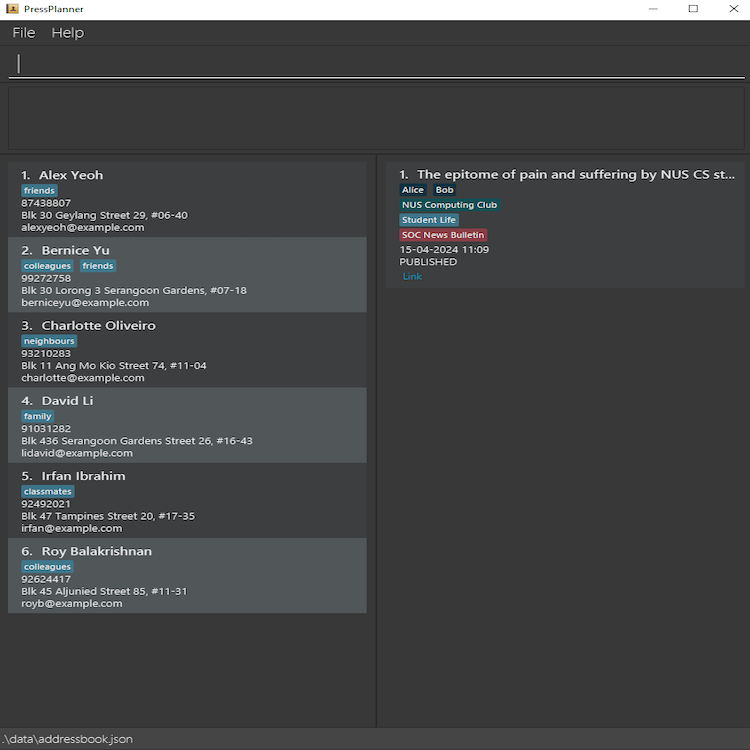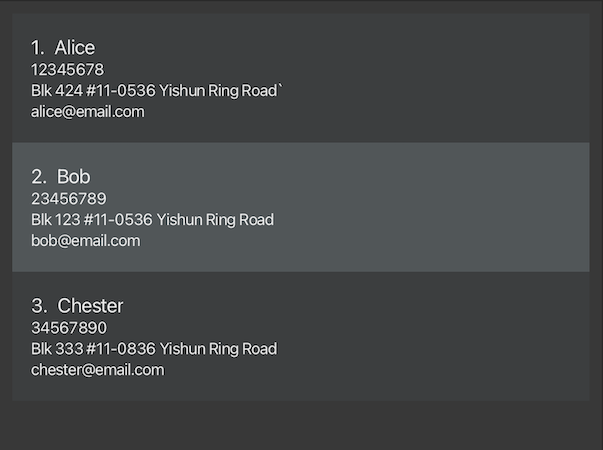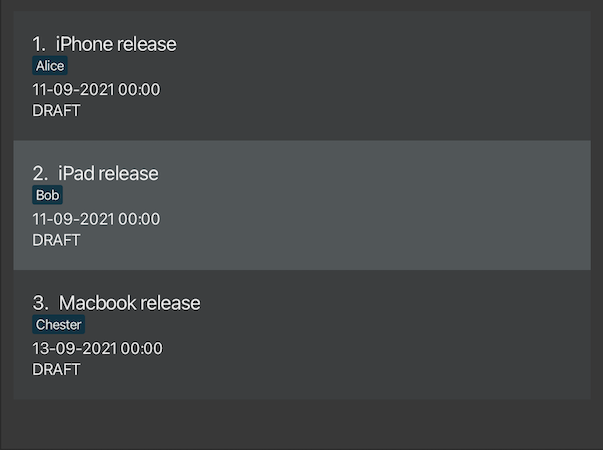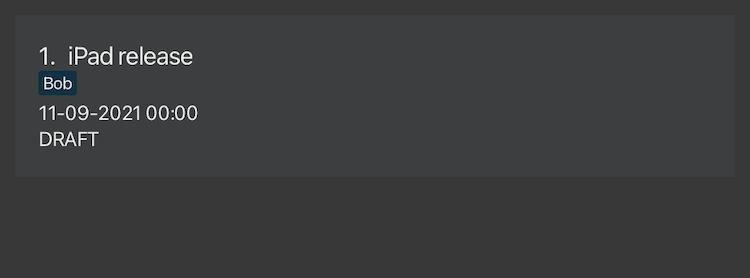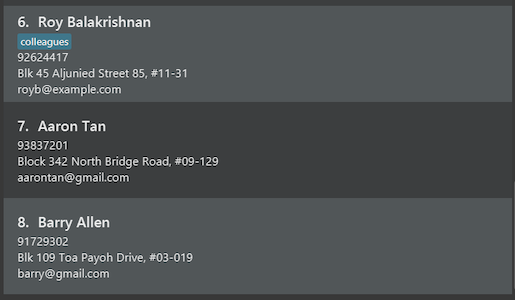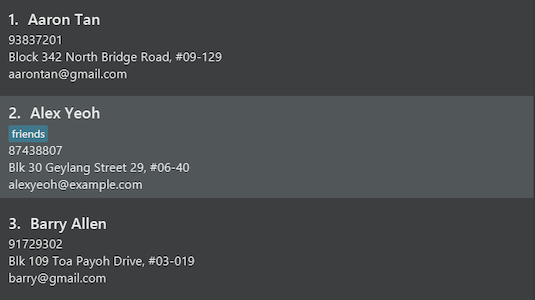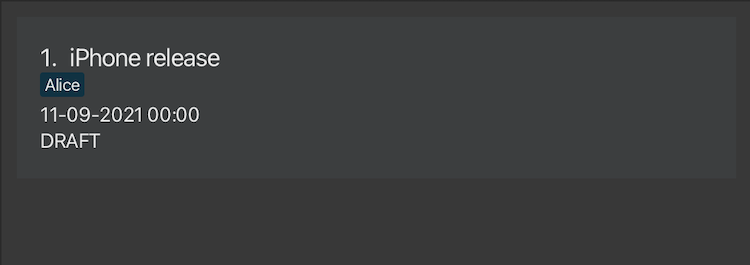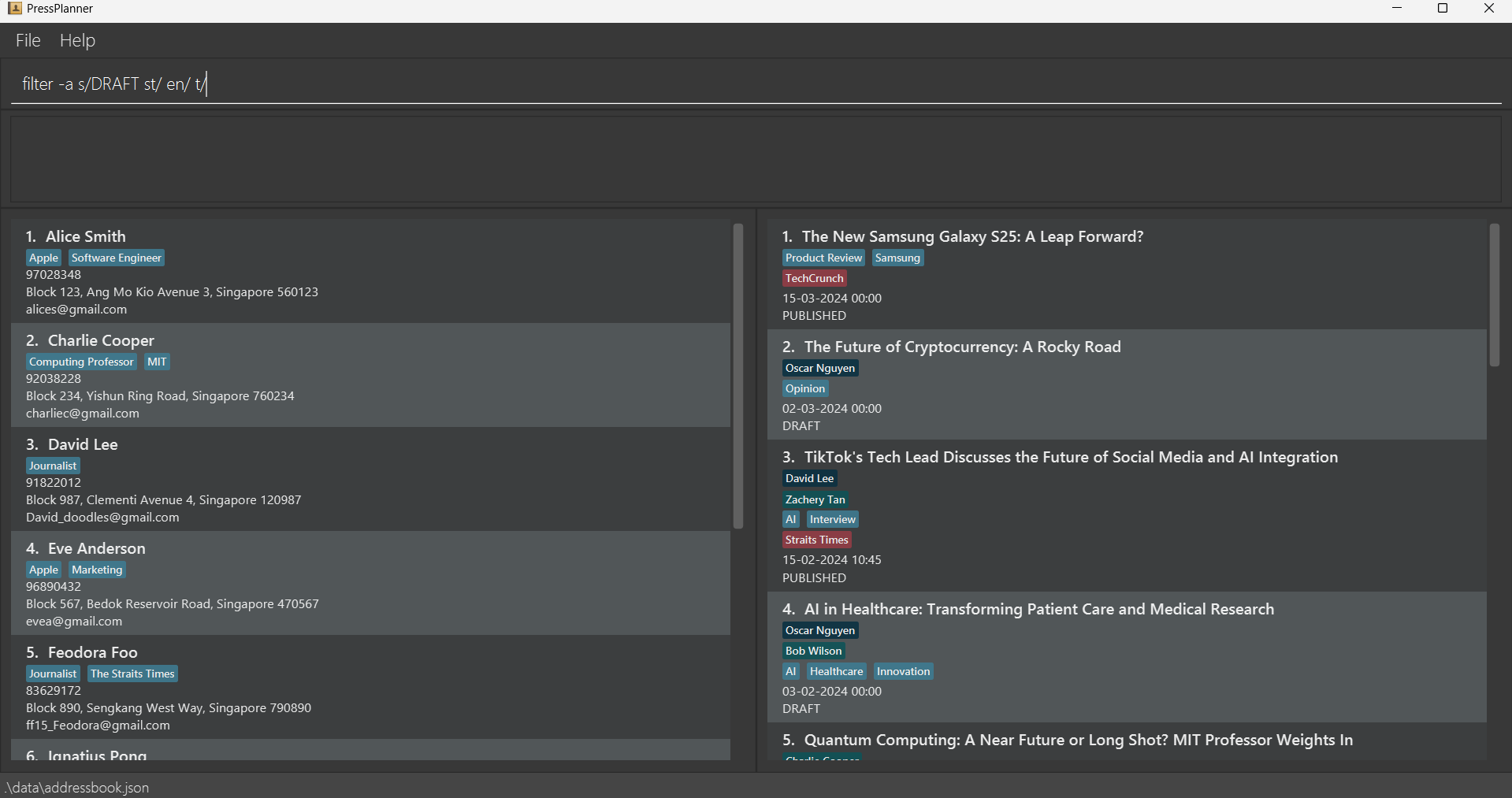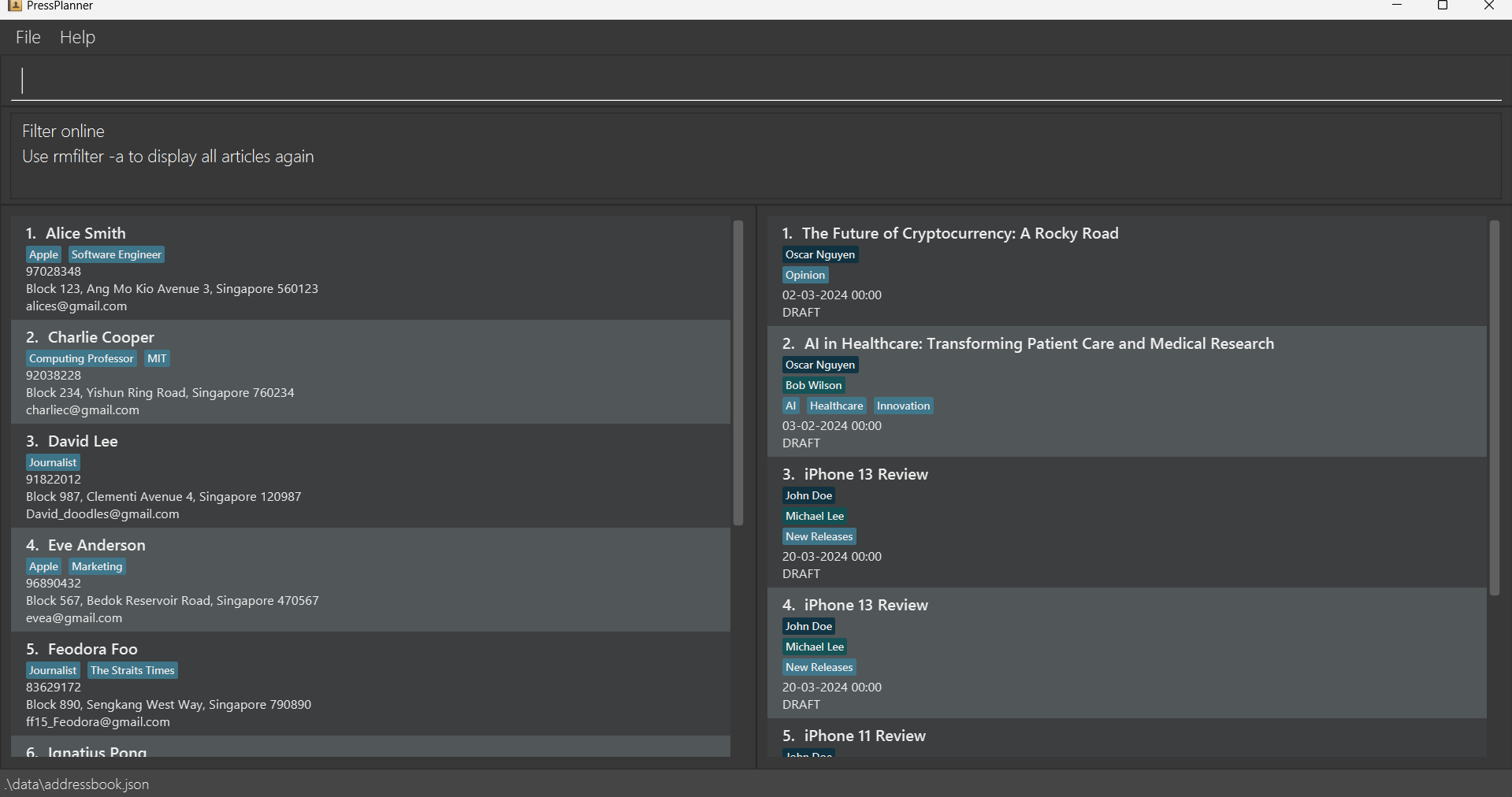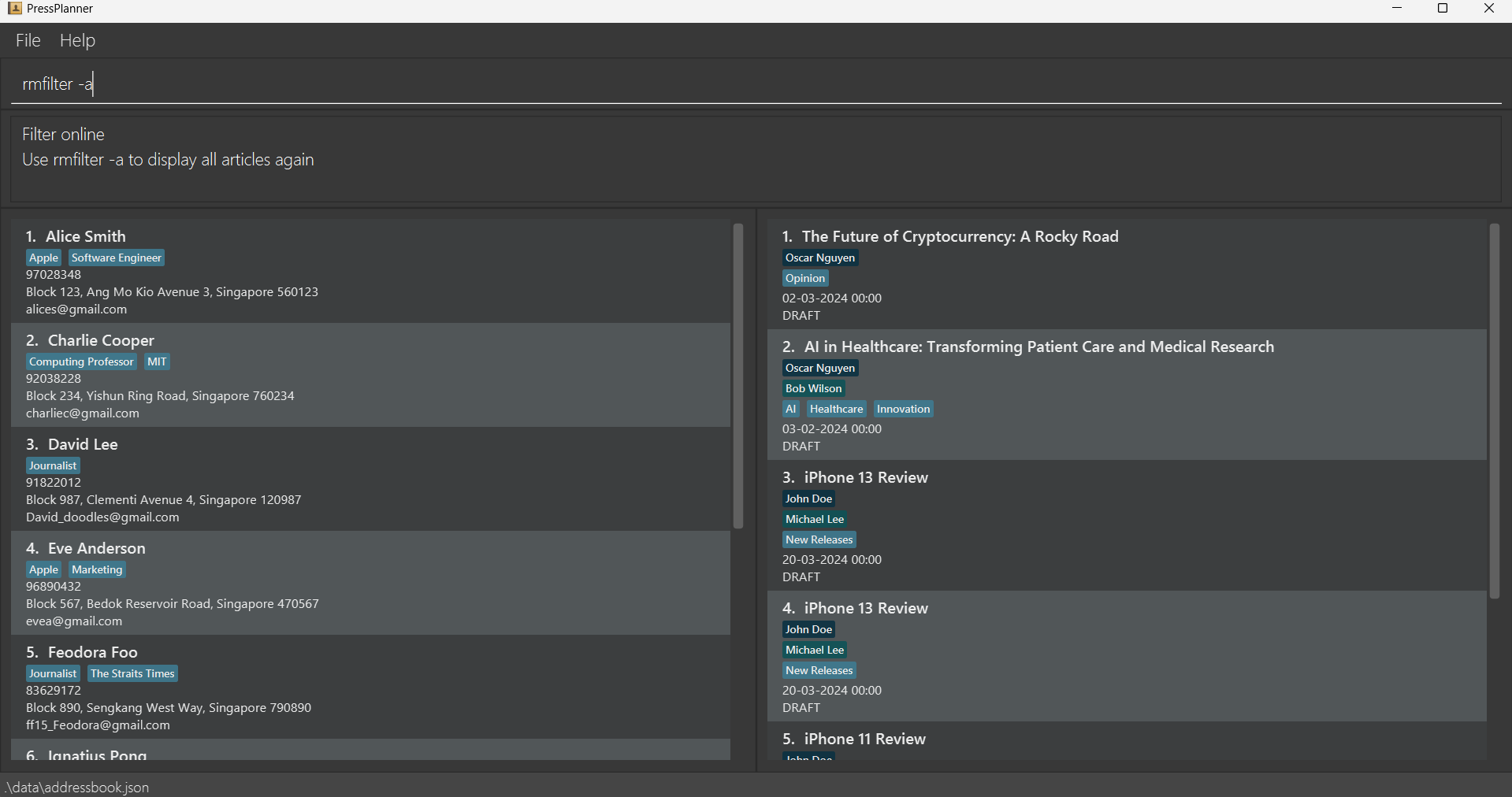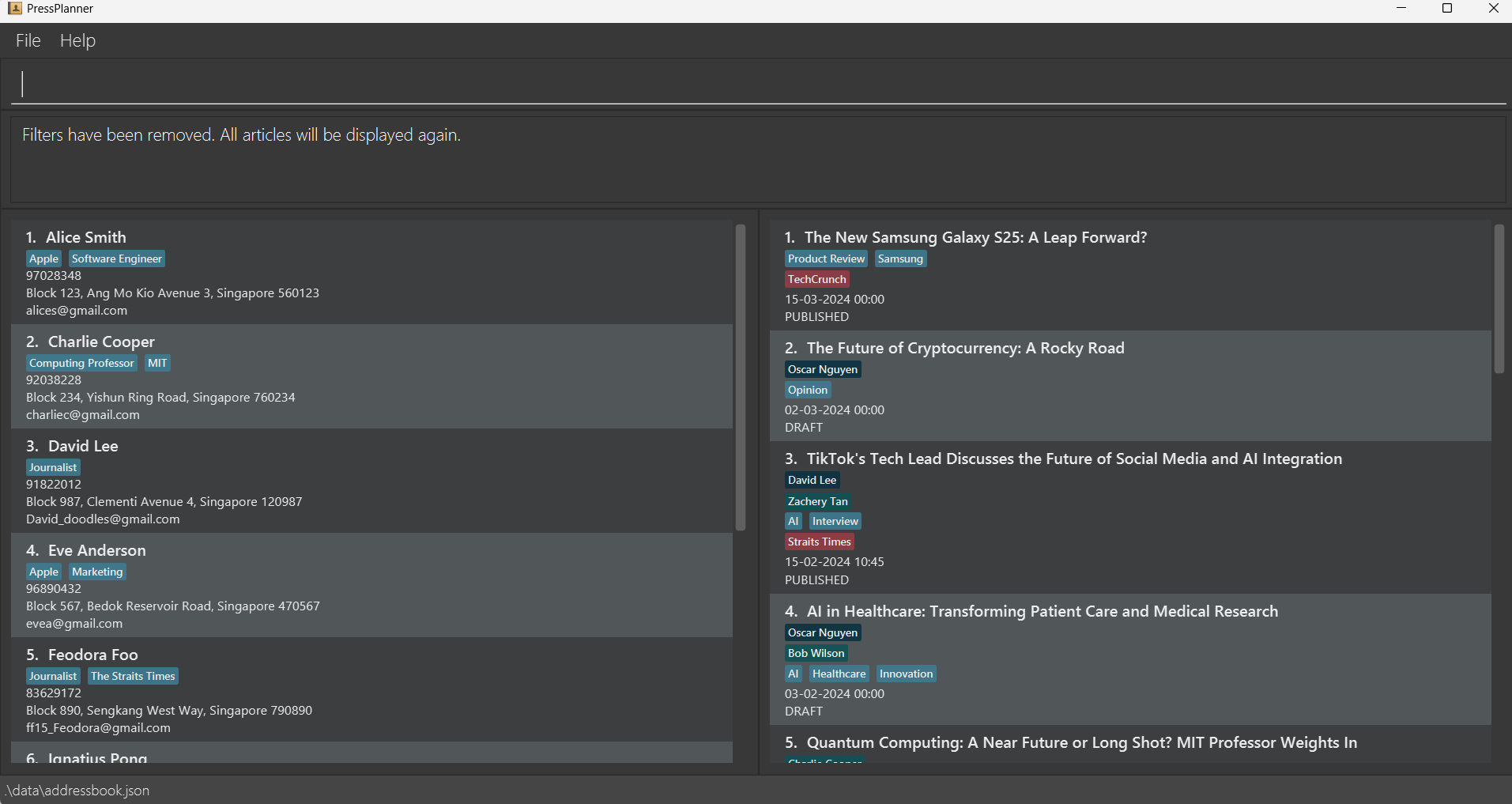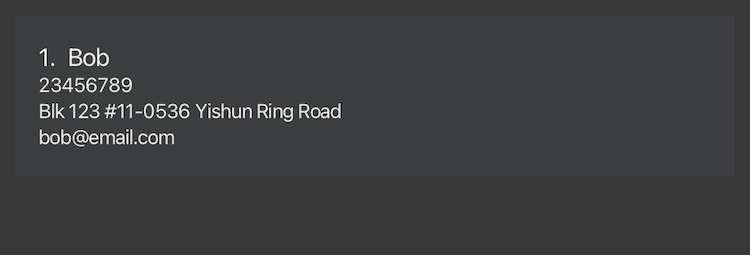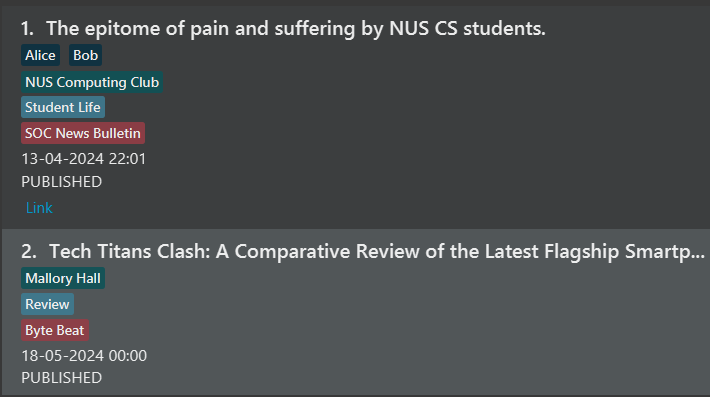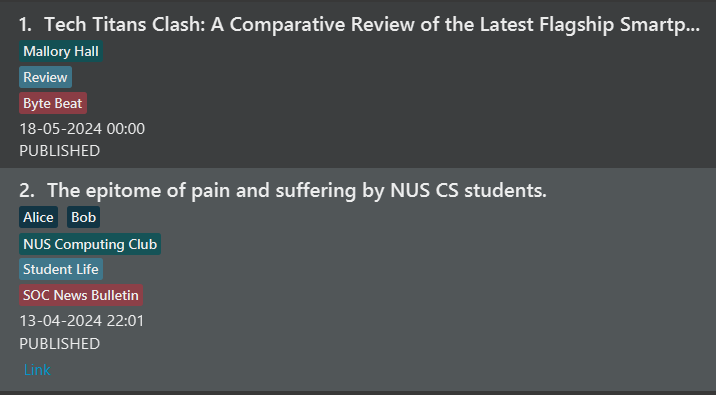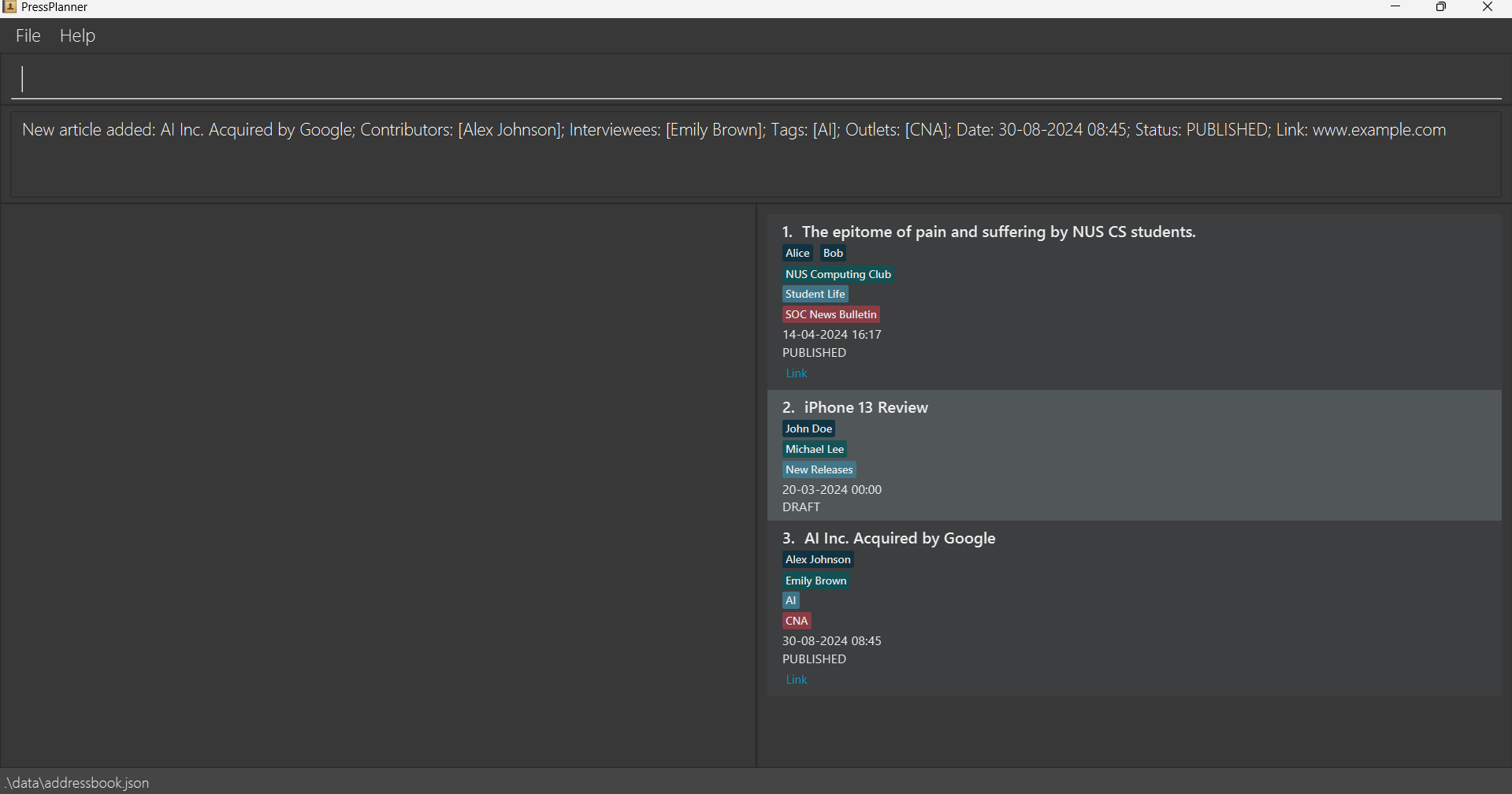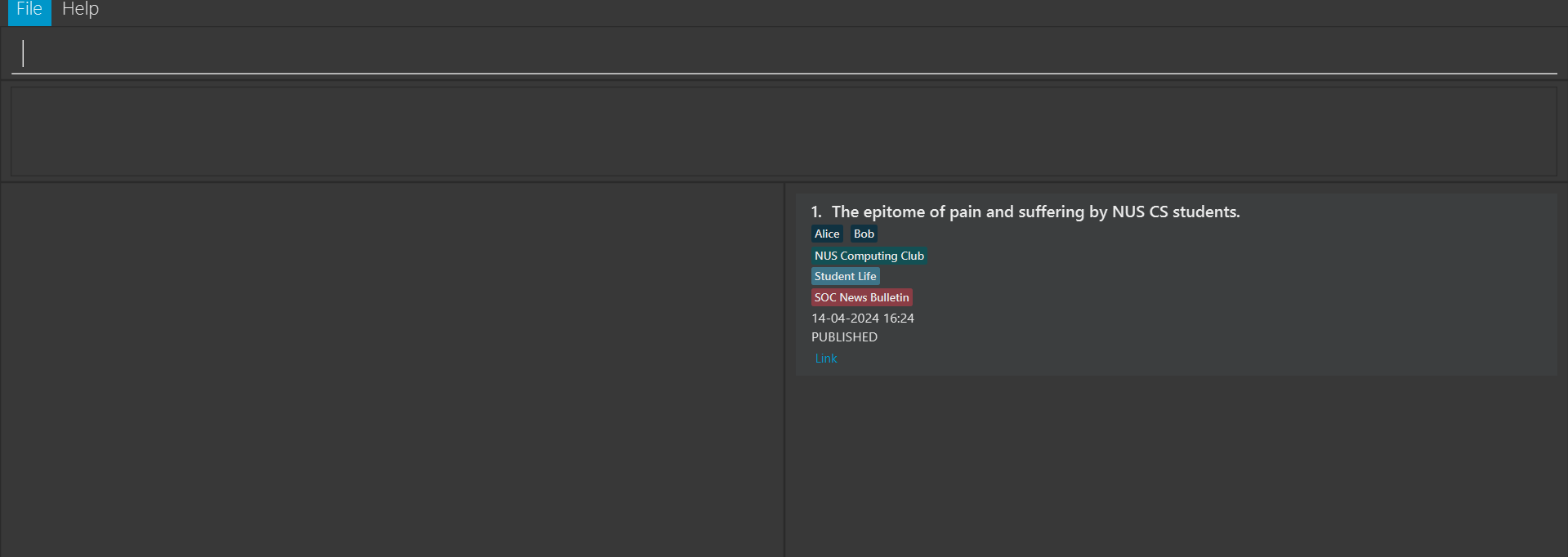PressPlanner User Guide
Table Of Contents
- 1. Introduction
- 2. Getting Started
- 3. Features
- 3.1. Managing Contacts
- 3.2. Managing Articles
- 3.2.1. Adding an Article
- 3.2.2. Deleting an Article
- 3.2.3. Listing All Articles
- 3.2.4. Editing an Article
- 3.2.5. Searching for an Article by Headline
- 3.2.6. Filtering Articles
- 3.2.7. Removing a Filter
- 3.2.8. Lookup Associated Persons
- 3.2.9. Sorting Articles by Date
- 3.2.10. Opening a Webpage for an Article
- 3.3. Other Commands
- 4. Commands Quick Reference
- 5. Upcoming Features
- 6. FAQs
1. Introduction
1.1. Using this Guide
This guide is intended to help you get started with PressPlanner. It will guide you through the installation process, provide a brief overview of the app's features, and give you a quick reference to the commands you can use. All sections headers will link you back to the start of their parent section, so you can easily navigate the guide.
1.2. Why Use PressPlanner?
PressPlanner was built with freelance journalists in mind. It acts as your contact list linked together with a collection of articles, helping you keep track of your contacts and articles.
Unlike major firms, freelancers often lack the same wealth of contacts and resources. PressPlanner helps you maximise the value you can get from your contacts, by providing a platform to store and manage them and keeping track of which contacts you've worked with for different articles.
PressPlanner's main features are its ability to help you:
Develop deeper story angles and reconnect with past interviewees or collaborators.
Follow up on breaking stories
- Filter by status and tags to find published articles related to breaking news.
- Make changes to your article as the story develops.
PressPlanner's tagging system for persons and articles is flexible and powerful:
- Customise your use of tags and still leverage the app's search and filter functions.
2. Getting Started
2.1. Installation
- Ensure that you have Java
11or above installed on your computer.- Download Java 11 from the official Oracle website.
- If you are unsure what version of java you have, use this guide to check.
- Download the jar file from our latest release.
- Move it to an Empty folder.
⚠️ Warning
App data will be stored in sub-folders from where it is launched. While you could run the app from any location, we recommend making a dedicated folder for our app to avoid confusion.
2.2. Launching the App
- Open a command terminal, change directories into the folder you put the jar file in, and use the
java -jar pressplanner.jarcommand to run the application.- For Windows users, you can use the
cdcommand to change directories and thedircommand to list files in the current directory. - For macOS and Linux users, you can use the
cdcommand to change directories and thelscommand to list files in the current directory.
- For Windows users, you can use the
- A window similar to the one below should appear in a few seconds. Note how the app contains some sample data. The information on what each data field represents is shown in the picture below.
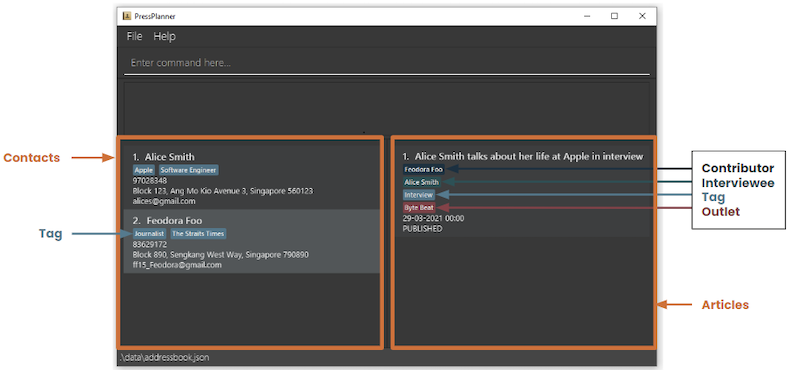
2.3. The Beginner's Guide to PressPlanner
💡 Tip
This section covers commands first-time users might need. For the full commands list, refer to the Features section.
Let's go over the basic PressPlanner workflow. Say you've just finished interviewing a certain Gill Bates. You want to save his contact for later and keep track of your article.
Selecting the command box at the top of the page, let's first add Gill Bates to PressPlanner's address book list.
To
adda contact we need to include the following information separated by their prefixes:- Name (
n/) - Phone number (
p/) - Email (
e/) - Address (
a/) - For example:
add n/Gill Bates p/12345678 e/gillbates@sicromoft.com a/Sicromoft HQ
ℹ️ Important
Adding an article uses the
add -acommand, the-astanding for article.- Note that the
-asuffix is used for all commands pertaining to articles.
- Name (
Next let's add that article you just wrote.
- To
add -aan article we need the following information:- Headline (
h/) - Date (
d/)- We use a single field for the date.
- Status (
s/)- An article can be a
draft,published, orarchived.
- An article can be a
- For example:
add -a h/Example Article d/20-10-2023 s/draft
- Headline (
- To
⚠️ Warning
You should only use headline (h/), date (d/) and status (s/) prefixes once each. If you use multiple prefixes only the last prefix's value will be used:
* eg. add -a h/My Article d/20-10-2023 s/draft h/My Second Article will add an article titled My Second Article.
* eg. add -a h/My Article d/01-01-2024 s/draft d/02-02-2024 will add an article with the date 02-02-2024.
Now that that's done, let's say you need to find Gill Bate's number to arrange another interview.
- Typing the command
find Gill Bateswill pull up his contact.
- Typing the command
If you made a mistake or want to see all your contacts again:
- Typing the command
listwill bring up all your contacts.
- Typing the command
If you want to look up your article:
- Typing the command
find -a Example Articlewill pull up the article.
- Typing the command
If you want to see all your articles again:
- Typing the command
list -awill bring them all up.
- Typing the command
Now that you know the basic workflow, go ahead and try it out for yourself. If you want to learn more commands, use the help command in-app or refer to the features section of this guide.
As you become more familiar with the app, use tags as you see fit to customise your workflow!
- Here are some ideas to get you started:
- Using tags to rate interviewees' compliance and reliability.
- Noting down how many clicks articles got in the first 24 hours.
- Using tags to mark articles with potential for follow-up development.
3. Features
ℹ️ Important
Here are some important terms that will be used in this section:
Commands are composed of a command word potentially followed by a few prefixes and their corresponding parameters.
- For the example command
example p/PARAMETER:exampleis the command word.p/is the prefix.PARAMETERis the parameter to be supplied by you.
- For the example command
INDEXis a parameter you may come across frequently. It refers to the index number shown in the current list view.
Words in
UPPER_CASEare the parameters to be supplied by you.- Refer to point 1 for the breakdown of the command structure.
- For the example command
example p/PARAMETER:PARAMETERis the parameter to be supplied by you.- The correct use of this command would thus be:
example p/my input, replacingPARAMETERwith your own input.
- The correct use of this command would thus be:
- For the real command
delete INDEX:INDEXis the parameter to be supplied by you.- The correct use of this command would thus be:
delete 1, replacingINDEXwith a valid index.
- The correct use of this command would thus be:
Items in square brackets are optional.
- For the example command
example p/PARAMETER [t/TAG]:example p/my inputis a valid use of the command.example p/my input t/my tagis also a valid use of the command.
- For the example command
Items with
...after them can be used multiple times. If the item is also in square brackets, it can even be used zero times.- For the example command
example p/PARAMETER [t/TAG]...:example p/my inputis a valid use of the command.example p/my input t/my tagis also a valid use of the command.example p/my input t/my tag t/my other tagis also a valid use of the command.
- For the example command
Parameters can be in any order.
- For the example command
example p/PARAMETER [t/TAG]...:example p/my input t/my tagis a valid use of the command.example t/my tag p/my inputis also a valid use of the command.example t/my tag p/my input t/my other tagis also a valid use of the command.
- For the example command
Extraneous inputs for commands that do not take in parameters will be ignored.
Prefixes are case-insensitive.
- Only prefixes are always case-insensitive, command words are case-sensitive.
- Refer to point 1 if you are unsure of the terminology and command structure.
- For the example command
example p/PARAMETER:example p/my inputis a valid use of the command.example P/my inputis also a valid use of the command.EXAMPLE p/my inputis not a valid use of the command.
- Only prefixes are always case-insensitive, command words are case-sensitive.
Only correct prefixes will be recognised and accepted.
- Taking the
add -acommand for example:- The command:
add -a h/My Headline invalid/ignore d/01-01-2024 s/draftwill not recogniseinvalid/ignoreas a valid prefix and parameter pair.- As a result, the command will interpret
My Headline invalid/ignoreas the headline and add a new article with the headlineMy Headline invalid/ignore.
- As a result, the command will interpret
- The command:
add -a h/My Headline d/01-01-2024 s/draft t/my tag invalid/ignorewill not recogniseinvalid/ignoreas a valid prefix and parameter pair.- As a result, the command will interpret
my tag invalid/ignoreas the attempted tag. - This will display an error message prompting you to only use alphanumeric characters for tags.
- As a result, the command will interpret
- The command:
- Taking the
⚠️ Warning
If you are using a PDF version of this document, be careful when copying and pasting commands with line breaks as they may not paste correctly.
3.1. Managing Contacts
ℹ️ Important
Here are some important terms that will be used in this section:
NAME- Names must be alphanumeric.
- Special characters are not allowed.
- Whitespaces are allowed.
PHONE_NUMBER- Phone numbers must be numeric only.
- Spaces and special characters are not allowed.
- Phone numbers must be at least 3 digits long.
EMAIL- Emails must be in the format
local-part@domain.- The local part can contain alphanumeric characters and the
+_.-special characters. - The domain part must be:
- Made up of domain labels separated by periods.
- End with a domain label of at least 2 characters.
- Have each domain label start and end with an alphanumeric character.
- Have each domain label contain only alphanumeric characters and hyphens.
- The local part can contain alphanumeric characters and the
- Emails must be in the format
ADDRESS- Addresses can contain any characters.
- Addresses cannot be left blank.
TAG- Tags are alphanumeric.
- Tags are any keyword or phrase that helps categorise the person.
- Customise your workflow with tags that make sense to you.
3.1.1. Adding a Person : add
Adds a person to PressPlanner's address book.
Format: add n/NAME p/PHONE_NUMBER e/EMAIL a/ADDRESS [t/TAG]...
💡 Tip
A person can have any number of tags (including 0).
Examples:
add n/John Doe p/98765432 e/johnd@example.com a/John street, block 123, #01-01add n/Betsy Crowe e/betsycrowe@example.com a/Apple HQ p/1234567 t/Marketing Department t/Apple
3.1.2. Deleting a Person : delete
Deletes the specified person from PressPlanner's address book.
Format: delete INDEX
- Deletes the person at the specified
INDEX.
Examples:
delete 2deletes the 2nd person in the current address book view.
ℹ️ Important
Commands such as find can alter the current view of the address book. The INDEX refers to the index number shown in the current view.
3.1.3. Listing All Persons : list
Shows a list of all persons in PressPlanner's address book.
- Use this command to restore the full list of persons after using other commands.
Format: list
3.1.4. Editing a person : edit
Edits an existing person in PressPlanner's address book.
Format: edit INDEX [n/NAME] [p/PHONE] [e/EMAIL] [a/ADDRESS] [t/TAG]...
- Edits the person at the specified
INDEX. - At least one of the optional fields must be provided.
- Existing values will be updated to the input values.
⚠️ Warning
When editing tags, the existing tags of the person will be removed i.e. adding of tags is not cumulative.
- You can remove all the person’s tags by typing
t/without specifying any tags after it.
ℹ️ Important
Editing the name of a person will automatically update their names in articles referencing them as contributors or interviewees.
Examples:
edit 1 p/91234567 e/johndoe@example.comEdits the phone number and email address of the 1st person to be91234567andjohndoe@example.comrespectively.edit 2 n/Betsy Crowe t/Edits the name of the 2nd person to beBetsy Croweand clears all existing tags.
3.1.5. Searching for a Person by Name : find
Finds persons whose names contain any of the given keywords.
Format: find KEYWORD [MORE_KEYWORDS]
- The search is case-insensitive. e.g.
hanswill matchHans. - The order of the keywords does not matter. e.g.
Hans Bowill matchBo Hans. - Only the name is searched.
- Only full words will be matched e.g.
Hanwill not matchHans. - Persons matching at least one keyword will be returned (i.e.
ORsearch). e.g.Hans Bowill returnHans Gruber,Bo Yang
Examples:
find JohnreturnsjohnandJohn Doefind alex davidreturnsAlex Yeoh,David LiBefore finding:
After finding using
find chester:
3.1.6. Lookup Associated Articles : lookup
Display articles associated with the person where they are contributors or interviewees.
Format: lookup INDEX
- Display articles related to the person at the specified
INDEX - The matching of persons to articles is based on the person's name.
- It is case-sensitive (e.g. Looking up
Johnin the address book will not match articles withjohnas an interviewee or contributor). - It is an exact match of the person's full name (e.g. Looking up
Johnin the address book will not match articles withJohnnyorJohn Doeas interviewees or contributors).
- It is case-sensitive (e.g. Looking up
Examples:
lookup 1returns all articles associated with the first person in the list of contacts.Before lookup:
After lookup using
lookup 2:
3.1.7. Sorting Persons by Name : sort n/
Sorts persons in ascending order by the lexicographical (alphabetical) ordering of their names.
Format: sort n/
- Executing the
sort n/command sorts all persons in PressPlanner permanently.- This works differently from commands which change the current view temporarily (e.g. find).
- Closing and reopening the app in future will result in contacts remaining sorted by name.
- Sorting is only done when the command is executed and not automatically maintained afterwards:
- A person added using
addafter asort n/command will be added to the end of the address book, regardless of their name. - A person edited using
editto change their name after asort n/command will not change its position in the address book.
- A person added using
Example:
sort n/sorts all persons in PressPlanner in ascending order by the lexicographical (alphabetical) ordering of their names.Before sorting:
After sorting:
Success message shown:
sorted all persons by name
3.1.8. Clearing All Persons : clear
Clears all entries from the address book.
Format: clear
⚠️ Warning
This action is irreversible. All persons will be deleted from the address book. The app will not prompt you to confirm this action.
3.2. Managing Articles
PressPlanner's article management system is designed to help you keep track of your articles and the people involved in them. As a freelancer, you lack the same resources a major firm has. PressPlanner helps you maximise the value you can get from your contacts by helping you keep track of which contacts you've worked with for different articles.
💡 Tip
Refer to Why Use PressPlanner? for some of our recommended workflows and how PressPlanner can help you.
ℹ️ Important
Here are some important terms that will be used in this section:
DATE- All articles have a mandatory
DATEfield. This field is also used in commands likefilter DATEmust be in the formatdd-mm-yyyy [HH:mm].HH:mmis optional and defaults to00:00if not provided.HH:mmmust be in 24-hour format.
- Examples of valid dates:
01-01-2023,01-01-2023 22:30
- All articles have a mandatory
STATUS- All articles have a mandatory
STATUSfield. STATUScan be:draftpublishedarchived.
- The
STATUSparameter is not case-sensitive (e.g.draftandDRAFTare both valid inputs).
- All articles have a mandatory
3.2.1. Adding an Article : add -a
Adds a new article to PressPlanner's database.
Format: add -a h/HEADLINE d/DATE s/STATUS [c/CONTRIBUTOR]... [i/INTERVIEWEE]... [t/TAG]...[o/OUTLET]... [l/LINK]
⚠️ Warning
- Only
HEADLINE,DATE, andSTATUSare mandatory fields.- Refer to Managing Articles for the valid formats of
DATEandSTATUS. - An article's
HEADLINEmust be unique unless it is adraftHEADLINEaccepts any characters, but spaces at the start will be automatically removed.HEADLINEcan also be left blank. This is not recommended, but allowed for flexibility.- e.g.
add -a h/ d/20-10-2023 s/draftis a valid command and will add an article with a blank headline. - Some users may find this useful for adding drafts quickly and filling in the headline later.
- e.g.
- An article's
DATEcan represent what you choose to be relevant to your workflow, we recommend using it to represent:- Time of creation for drafts.
- Time of publication for published articles.
- Refer to Managing Articles for the valid formats of
- Entering multiple prefixes for any of these fields will overwrite the previous values.
- e.g.
add -a h/My Article d/20-10-2023 s/draft h/My Second Articlewill add an article titledMy Second Article. - e.g.
add -a h/My Article d/01-01-2024 s/draft d/02-02-2024will add an article with the date02-02-2024.
- e.g.
- A
CONTRIBUTORis a co-author or information source that was not directly interviewed for an article. - An
INTERVIEWEEis a person directly interviewed for an article. - An
OUTLETis the publication or platform the article was published on. - A
TAGis any keyword or phrase that helps categorise the article. - A
LINKis a URL to the article.
ℹ️ Important
Adding an article will return to displaying all articles if a find command was executed before.
- This does not apply to filters.
Examples:
add -a h/iPhone 13 Review d/20-03-2024 s/draft c/John Doe i/Michael Lee t/New Releasesadd -a h/AI Inc. Acquired by Google d/30-08-2024 08:45 s/published c/Alex Johnson i/Emily Brown t/AI o/CNA l/www.example.com
3.2.2. Deleting an Article : delete -a
Deletes an existing article from PressPlanner's database.
Format : delete -a INDEX
- Deletes the article at the specified
INDEX.- The
INDEXrefers to the index number shown in the current article list view.- If a
filter,sortorfindcommand was executed before, the index refers to the index number shown in the filtered/sorted list of articles. - e.g.
delete 1after thefindcommand deletes the first article found by thefindcommand.
- If a
- The
Example : delete -a 1 deletes the article at the first index.
3.2.3. Listing All Articles : list -a
List out all articles in PressPlanner's database.
Format: list -a
- No parameters necessary.
- Extra characters in the command (e.g.
list -ab,list -a1) will be ignored and treated aslistfor persons instead. - Extra whitespace characters in the command (e.g.
list -a,list -a) are acceptable. - Extra characters after a whitespace will be ignored (e.g.
list -a 123will be interpreted aslist -a).
- Extra characters in the command (e.g.
3.2.4. Editing an Article : edit -a
Edits an existing article in PressPlanner's database.
Format: edit -a INDEX [h/HEADLINE] [d/DATE] [s/STATUS] [c/CONTRIBUTOR]... [i/INTERVIEWEE]... [t/TAG]... [o/OUTLET]... [l/LINK]
- Edits the article at the specified
INDEX. - At least one of the optional fields must be provided.
- Refer to the
add -acommand for the format of each field.- Note that
edit -awill also behave the same asadd -ain terms of returning to the full list of articles if used after afindcommand.
- Note that
⚠️ Warning
- Editing an article will be updated any included field to the new input.
- i.e. The original values will be overwritten by the new values.
c/,i/,t/,o/andl/without any value after it will clear all existing values.- e.g.
c/new contributorwill replace all existing contributors withnew contributor.
- i.e. The original values will be overwritten by the new values.
- Editing is irreversible, so make sure you have the correct information before executing the command.
Examples:
edit -a 1 h/iPhone ReviewEdits the headline of the 1st article to beiPhone Review.edit -a 2 h/iPhone Review i/Edits the headline of the 2nd article to beiPhone Reviewand clears all existing interviewees.
3.2.5. Searching for an Article by Headline : find -a
Find articles with headlines containing any of the given keywords.
Format: find -a KEYWORD [MORE_KEYWORDS]
- Only the headline is searched for matches.
- The search is case-insensitive.
- e.g
iphonewill matchiPhone
- e.g
- The order of the keywords does not matter.
- e.g.
Pro Visionwill matchVision Pro
- e.g.
- Only full words will be matched.
- e.g.
iPhonewill not matchiPhones
- e.g.
- Articles matching at least one keyword will be returned.
- e.g.
find -a Vision Prowill return an article with the headline:Pro tips for Windows 10 Users
- e.g.
Examples:
find -a Vision Proreturns articles with headlines containingVisionorPro.Before finding:
After finding using
find -a iphone:
3.2.6. Filtering Articles : filter -a
Filter PressPlanner's database by a combination of attributes to find articles you are looking for quickly.
Format: filter -a s/STATUS t/TAG ST/START_DATE EN/END_DATE
- All the prefixes need to be included, but can be left blank.
- e.g.
filter -a s/ t/ st/ en/is a valid command - e.g.
filter -a s/ t/ st/is not a valid command - Leaving
st/oren/blank defaults to the earliest or latest date possible respectively.
- e.g.
- Use the
filtercommand prior to afindcommand.filterwill list all matching articles within the database when first applied.findcan be used to then search the filtered list.- Using
filterafter afindcommand will overwrite the previousfindcommand.
- Using
- Filters are not stored between sessions, so make sure to finish your search before closing the app!
- Filters will apply until you remove it or apply a new filter, so make sure you remove it after you are done!
- Refer to the add article command for the format of each field.
- Note that
START_DATEandEND_DATEmust be in the same format asDATEin the add article command. - The
START_DATEshould come before theEND_DATE. If not, you will receive an error! - The date of the article you are looking for should not be equal to the
START_DATEorEND_DATE.
- Note that
- Only one filter command can be active at once, using another filter will override the last one.
Examples:
filter -a s/DRAFT t/ st/ en/will restrict the display to showing only articles with draft status.Using the command:
After the command:
3.2.7. Removing a Filter : rmfilter -a
Remove all filters so that all articles in PressPlanner's database are displayed.
Format: rmfilter -a
No additional parameters.
The
-ais necessary, additional letters will cause the command to fail.- Additional parameters after a whitespace will be ignored (e.g.
rmfilter -a 123will be interpreted asrmfilter -a).
- Additional parameters after a whitespace will be ignored (e.g.
Using the command:
After the command:
3.2.8. Lookup Associated Persons : lookup -a
Finds persons associated with an article as interviewees or contributors.
Format: lookup -a INDEX
- Display list of persons related to the article at the specified
INDEX. - The matching of articles to persons is based on the person's name.
- It is case-sensitive (e.g. Looking up an article with
johnas an interviewee or contributor will not matchJohnin the address book). - It is an exact match of the person's full name (e.g. Looking up an article with
Johnas an interviewee or contributor will not matchJohnnyorJohn Doein the address book).
- It is case-sensitive (e.g. Looking up an article with
Examples:
lookup -a 1returns all persons associated with the first article in the list of articles.Before lookup:
After lookup using
lookup -a 2:
3.2.9. Sorting Articles by Date : sort -a d/
Sort articles in PressPlanner's database in descending order by their date and time.
Format: sort -a d/
- Executing the
sort -a d/command sorts all articles in PressPlanner permanently. - Sorting is only done when the command is executed and not automatically maintained afterwards:
- An article added using
add -aafter asort -a d/command will be added to the end of the list, regardless of its date. - An article edited using
edit -ato change the date after asort -a d/command will not change its position in the list.
- An article added using
Example:
sort -a d/sorts all articles in PressPlanner in descending order by their date and time.Before sorting:
After sorting:
Success message shown:
sorted all articles by date
3.2.10. Opening a Webpage for an Article
By clicking the
Linkbutton of your article that is highlighted in yellow box in the picture below, you can open up the webpage for your article that was included in the article.
⚠️ Warning
PressPlanner does not check the validity of links. If the webpage does not open when clicked, it likely means that the link of the article is invalid.
3.3. Other Commands
3.3.1. Viewing Help : help
Shows a message with the URL to access this User Guide.
Can also be accessed via the button at the top of the app
Can also be accessed via pressing the
F1key on your keyboard
Format: help
3.3.2. Exiting PressPlanner : exit
Exits the program.
Format: exit
4. Commands Quick Reference
| Action | Command Format | Example |
|---|---|---|
| List Persons | list | list |
| Add Person | add n/NAME p/PHONE_NUMBER e/EMAIL a/ADDRESS [t/TAG]... | add n/Betsy Crowe p/1234567 e/betsycrowe@example.com a/Apple HQ t/Marketing Department t/Apple |
| Delete Person | delete INDEX | delete 3 |
| Edit Person | edit INDEX [n/NAME] [p/PHONE_NUMBER] [e/EMAIL] [a/ADDRESS] [t/TAG]... | edit 2 n/Betsy Crowe e/betsycrowe@example.com |
| Find Person | find KEYWORD [MORE_KEYWORDS] | find Crowe Betsy |
| Lookup Associated Articles | lookup INDEX | lookup 1 |
| Sort Persons by Name | sort n/ | sort n/ |
| Clear Persons | clear | clear |
| List Article | list -a | list -a |
| Add Article | add -a h/HEADLINE d/DATE s/STATUS [c/CONTRIBUTOR]... [i/INTERVIEWEE]... [t/TAG]... [o/OUTLET]... [l/LINK] | add -a h/AI Inc. Acquired by Google d/30-08-2024 08:45 s/published c/Alex Johnson i/Emily Brown t/AI o/CNA l/www.example.com |
| Delete Article | delete -a INDEX | delete -a 1 |
| Edit Article | edit -a INDEX [h/HEADLINE] [d/DATE] [s/STATUS] [c/CONTRIBUTOR]... [i/INTERVIEWEE]... [t/TAG]... [o/OUTLET]... [l/LINK] | edit -a 2 h/iPhone Review |
| Find Article | find -a KEYWORD [MORE_KEYWORDS] | find -a Vision Pro |
| Filter Articles | filter -a s/STATUS t/TAG ST/START_DATE EN/END_DATE | filter -a s/draft t/Apple st/01-01-2024 en/ |
| Remove Filter | rmfilter -a | rmfilter -a |
| Lookup Associated People | lookup -a INDEX | lookup -a 1 |
| Sort Articles | sort -a d/ | sort -a d/ |
| Help | help | help |
| Exit | exit | exit |
5. Upcoming Features
5.1. Clearing all Articles
In PressPlanner's current version, we have provided a command to clear all persons from the address book using the clear command. This is intended to help you clear all contacts in the case of personal data privacy and security concerns.
Users have requested a similar command to clear all articles from the article book to improve their personal workflows. We are working on implementing this feature in the near future.
- In the meantime, you can manually delete the
articlebook.jsonfile in thedatafolder to clear all articles.For example, your articlebook may look something like this:
Simply go into the folder PressPlanner is in:
Go inside the data folder, which will look something like this:
Delete the file named articlebook:
Now, if you open PressPlanner again, you will see that your articles will have changed back to the sample data:
Now all you have to do is to delete the sample article, and you are set!
5.2. Filtering People
In PressPlanner's current version, filtering is available for articles and intended to help you find articles that you may have forgotten the name of by other attributes such as date, status, tags, etc.
Users have requested a similar feature for persons. We are working on implementing this feature in the near future.
6. FAQs
6.1. Why am I unable to run PressPlanner on my desktop?
- Please check that you have downloaded Version 11 Java SDK that suits your computer’s operating system (Windows, MacOS, Linux).
- If you are unsure of whether you have done so, please navigate back to the “Getting Started” Segment of the User Guide to access the link which will bring you to the Java Oracle Website where you can re-download the Version 11 Java SDK for your operating system.
6.2. How do I ensure that I have saved all the contacts and articles I have added in this session?
- Do not worry about issues regarding the saving of data you have entered into the application, they are saved into files automatically upon the execution of every command which modifies or adds new data.
6.3. Why were all my previous data for contacts (and / or) articles from previous sessions deleted and replaced by the default template data?
- This means that your save file was either corrupted or lost. To avoid this, refrain from editing files in the data folder (specifically AddressBook.json and ArticleBook.json files which contain the saved contacts and articles respectively, from previous sessions) unless you are sure about what you are doing.
- To mitigate possible accidental data corruption which may result in the deletion of the save files, please make a copy of the data files after every session where major changes were made, so that in the event the most recent data is lost, you would still have a recent data file which can then be added back into the data folder located at the working directory of the PressPlanner.jar file and be loaded up into the application.
6.4. Why does my link not open the browser?
- This means that your URL added to the PressPlanner is an invalid link.
- To let you know when the URL is invalid, we will soon be implementing the app to show you an error message when your link that is typed is invalid. Please wait for our future updates!
